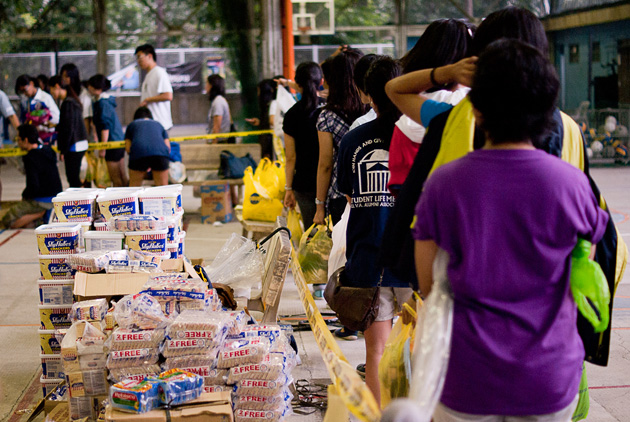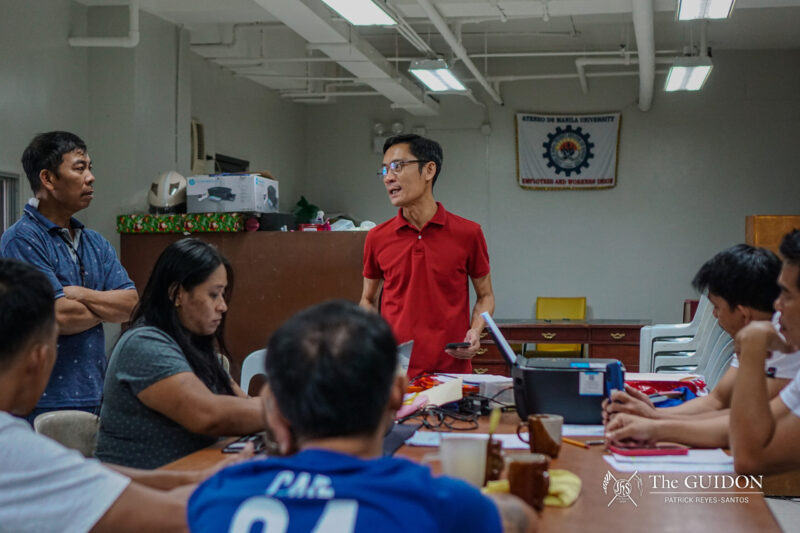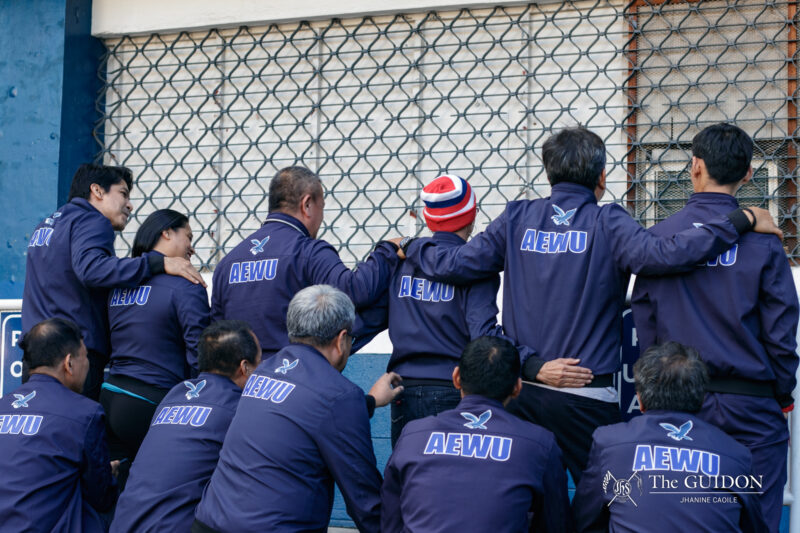
COMMUNITY EFFORT. Relief operations ran for five days, as students and teachers volunteered to pack and transport donations. Photo by Adrian F. Begonia
THE ATENEO raised about P2 million in cash donations and doled out an estimated 30,900 ready-to-eat meals and 13,000 family packs of relief goods to the victims of the heavy monsoon rains in early August.
Members of the community took part in the relief operations initiated by the Ateneo de Manila Disaster Response and Management (Dream) Team. The relief operations were held from August 7 to 11 at the Loyola Schools Covered Courts.
The Ateneo Dream Team is under the office of the Vice President (VP) for Social Development. It is a team which mobilizes all the various units of the Ateneo, which includes the grade school, high school, Loyola Schools and the professional schools.
“We bring [the Ateneo community] together and coordinate the efforts among these 10 schools,” VP for Social Development Jaime Hofileña said.
Simbahang Lingkod ng Bayan (SLB) also helped in the operations. SLB is a non-partisan, Jesuit-led organization based in the Loyola House of Studies.
Team protocol
Hofileña said that the Dream Team is “a community that is activated in times that you need it.”
On August 7, Hofileña already started calling for the Dream Team to assemble since the rains were not changing in intensity.
Council of Organizations of the Ateneo (COA) point person Micha Aldea said that they were able to respond right away, immediately calling representatives from the administration, the Sanggunian, COA, Ateneo Resident Students Association (ARSA) and the Office for Social Concern and Involvement (OSCI).
“It was patterned from the relief operations done three years ago during Ondoy so it wasn’t that hard because they already have protocols,” she said.
For the first day of the relief operations, the Dream Team focused on knowing how the students were doing. They released a link to a Google Docs file on social networking sites, and asked students indicate their respective situations.
“[What] we did was we just responded to their call,” Aldea said. “If they need rescue, we call their area’s Local Government Unit, MMDA, Red Cross and National Disaster Risk Reduction and Management Council to rescue them.”
Relief operations process
“OSCI, with the help of ROTC, started to deploy meals to the partner communities of the Ateneo… from the Ateneo High School’s (AHS) centralized kitchen,” said Aldea. “So buong Ateneo effort talaga (So it was really an effort of the whole Ateneo community).”
The team also opened the call for donations at the Cervini Hall. The Cervini Recreation Room and Singson Hall were opened for evacuees, and the parking lot was opened for their vehicles.
The San Jose Major Seminary on campus opened its halls to evacuees as well, while the babies of the Cribs Foundation, a leading child-caring agency licensed by the Department of Social Welfare and Development, were evacuated to the Loyola House of Studies.
The team eventually transferred the donations from Cervini to the Covered Courts and accepted donations like water, clothes, medicines and goods. They also began to mobilize and call for volunteers.
“On the first day, the people who responded were really Arsans. Biglaan eh (It was urgent),” said ARSA President Kat Tuason, who was one of the heads of the relief operations. “We can’t blast something in the event that we need volunteers and at the peak of the weather, so mainly it was Arsans that helped out.”
It was a different situation for the second day because the whole team was surprised and overwhelmed by the number of volunteers who went to help.
“Dagsaan ng volunteers (There was an influx of volunteers),” said Tuason. “It’s overwhelming and I was touched because lots of them responded.”
Tuason also said that it was indeed the most tedious day for them. “There were many donations that we had to transfer and we had to take note of the donors and thank them in the end.”
For the following days, the Dream Team decided to implement shifting schedules to control the number of volunteers and conduct a more efficient operation.
They started with the shifting system on August 9. There were four shifts, with 250 volunteers for each shift. For the succeeding days, they lessened the shifts to three, with 200 volunteers each.
Practicing what is preached
Prioritized to receive relief goods from the Ateneo were the school’s partner communities, such as OSCI and student organization immersion sites.
Ateneans welcomed the idea of serving other communities as well. “We have a hotline so some of them called in to ask for help,” Tuason said.
Aldea said, “We prioritized the Ateneo[-partnered] communities since we have their contact numbers. It’s important that you have their contact so they know that help is coming.”
Sophomore Alex Garcia said that the reason she volunteered was that she really wanted to help those who were affected by the calamity. “It was my way of thanking God for keeping me safe during the time when some people were experiencing the worst.”
Tuason said that despite the constant pouring of rain, the volunteers still helped in the relief operations. “That made me realize the value of the ‘men and women for others’ that the Ateneo instilled in their students.”
Aldea also said that it was really humbling to see people volunteering even after their shifts.
“You see the value of the Ateneo community and everyone went out of their comfort zones,” she said.
“Sila talaga nag-a-unpack ng canned goods, nagfo-fold, and iyong iba, nagpapabasa pa ng ulan to deliver the goods from the trucks (They were really the ones who unpacked the canned goods and folded [the shirts], and the others even went as far as braving the rain to deliver the goods from the trucks).”
Hofileña said, “I’d like to think that it is not lost on the Ateneo community—that this is real embodiment of the Ignatian spirit of generosity, magis.”
“It’s good that in a community like Ateneo, there is an opportunity to put into practice what we preach.”







